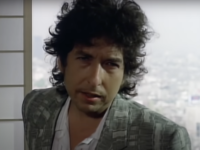Sometimes it’s best to give thanks. To forgive the wrongs life has done us. To look at simple things: a tree against the sky, the reflection of sunlight on water, the brush of a hand that we love.
To give thanks that these things are as they are and that we are among them, with a heart that can meet their beauty with a joy of its own. To remind ourselves that we are here only for a while, that everything passes as quickly as a dream, and that there’s a beauty and a glory in the passing.
Sometimes it’s best to give thanks. And sometimes it helps to have Thanksgiving songs to remind us. Here are five singers who knew bitterness and despair but came through with a song of gratitude anyway:
KATE WOLF, “THESE TIMES WE’RE LIVING IN” (GIVE YOURSELF TO LOVE VOL. 1, 1983): Kate Wolf wrote many songs of love and wisdom and pain, but this might well be her greatest. It paints a series of portraits of life that’s as poignant as it is simple. The warmth in her voice weaves the images into a deeply felt hymn to life, which reaches its highpoint in the beautiful final verse. “The days like flowers bloom and fade and they do not come again,” Kate Wolf sings, followed by a refrain that reminds us of the preciousness of all that passes away.
BILL FAY, “THE NEVER ENDING HAPPENING” (LIFE IS PEOPLE, 2012): A moody progression of piano chords sets the scene for one of the strongest moments of Bill Fay’s comeback album. As with Kate Wolf’s song, a note of profound sadness underscores the voice of gratitude. The deepest joy and sorrow are never far apart, it seems: both lie in the awareness that we are passing away even as we are learning to sing the song of our life.
Bill Fay sings his with an authority and depth of feeling reflected in lyrics that evoke the beauty and the pain of life: “For some it’s like tight-rope walking, blindfolded and shaking, on either side fear and pain, for some it’s like tight-rope walking.” But also: “The never-ending happening of what’s to be and what has been: just to be a part of it is astonishing to me.” A gorgeous cello solo concludes the song, bringing home the message and sailing into the silence where words cannot reach.
JOAN BAEZ, “GRACIAS A LA VIDA [VIOLETA PARRA],” (GRACIAS A LA VIDA, 1974): Written by Chilean folk singer Violeta Parra a few years before she took her own life, “Gracias a la Vida” is one of the more beautiful and tragic Thanksgiving songs. In light of this fact, some have read the lyrics as an ironic goodbye to the world. Yet, to me, the words are too hopeful and thankful to warrant such a reading. It seems more likely that Parra’s gratitude was evoked by her feeling that the end was drawing near.
The version by Joan Baez has always been the most moving to me. Baez knew how to take a song and bring out its depth and clarity of feeling, and “Gracias a la Vida” is a perfect match for her voice. Breathing life into Violeta Parra’s lyrics, she thanks the life that has given her so much: vision and hearing, mountains and deserts, words to think and say, and, above all, the sweet voice of her beloved.
BOB DYLAN, “EVERY GRAIN OF SAND” (SHOT OF LOVE, 1981): At the tail-end of Bob Dylan’s religious phase, when the fire and brimstone of his fanaticism had died down to a purer flame, he recorded one of the most profound Thanksgiving songs. Channeling William Blake (“to see a world in a grain of sand”), Dylan tells of his journey through despair and sorrow, temptation and loneliness, that finally led to the single moment of vision when he saw the master’s hand “in every leaf that trembles, and in every grain of sand.”
Whatever our religious beliefs, we can never doubt the sincerity of feeling that drives “Every Grain of Sand” and fuels some of the richest imagery by Bob Dylan or any other songwriter: “I have gone from rags to riches in the sorrow of the night, in the violence of a summer’s dream, in the chill of a wintry light, in the bitter dance of loneliness fading into space, in the broken mirror of innocence on each forgotten face.”
I, last least voice of her voices,
Give thanks that were mute in me long
To the soul in my soul that rejoices
For the song that is over my song
Time gives what he gains for the giving
Or takes for his tribute of me;
My dreams to the wind everliving,
My song to the sea.
ALGERNON CHARLES SWINBURNE, “BY THE NORTH SEA” (THE COMPLETE WORKS, 2014): Some can sing without an instrument or a voice. Such a singer was Algernon Charles Swinburne, who turned 19th-century poetry into a music of images and sounds that can rival any ‘real’ song. Like many musical artists, he lived a life of excess and rebellion against the social and political status quo, hoping to burn out by the time he was thirty.
Yet, surprising all, he made it through the rage and pain of his early life and found unhoped-for peace and quiet in his later years. In the last verses of the long poem “By the North Sea,” featured above, he finally made the crossing from bitterness to gratitude. It is the same crossing that Kate Wolf, Violeta Parra, Bob Dylan and Bill Fay expressed in their timeless songs.
- Why Warren Zevon Shouldn’t Only Be Remembered For a Novelty Single - September 7, 2023
- Thanksgiving Songs From Bob Dylan, Joan Baez + Others: Gimme Five - November 25, 2021
- Dory Previn, “The Lady With the Braid” (1971): One Track Mind - November 27, 2019



